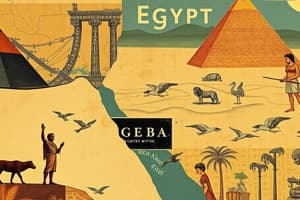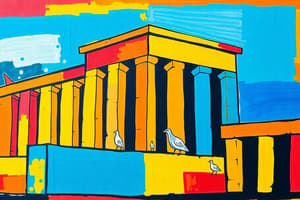Podcast
Questions and Answers
What purpose does a monument serve?
What purpose does a monument serve?
What is a sarcophagus commonly associated with?
What is a sarcophagus commonly associated with?
Who was the archaeologist known for discovering King Tut's tomb?
Who was the archaeologist known for discovering King Tut's tomb?
What type of rock commonly covered the pyramids?
What type of rock commonly covered the pyramids?
Signup and view all the answers
Which of the following describes Hatshepsut?
Which of the following describes Hatshepsut?
Signup and view all the answers
What is the significance of inscriptions?
What is the significance of inscriptions?
Signup and view all the answers
What body of water was created by the construction of the Aswan High Dam?
What body of water was created by the construction of the Aswan High Dam?
Signup and view all the answers
Which pharaoh is noted for having numerous children?
Which pharaoh is noted for having numerous children?
Signup and view all the answers
Study Notes
Monuments
- Monuments can be large statues or buildings.
- They are often made to honor a person or event.
- They are designed to last a long time.
- They are preserved because of their historical or cultural importance.
Inscriptions
- Inscriptions are a way of keeping historical or religious records.
- They are carved, pressed, or painted into stone, brick, metal, or other hard surfaces.
Sarcophagus
- A sarcophagus is an ancient stone or marble coffin.
- They are often decorated with sculpture and inscriptions.
- King Tut's sarcophagus was made of solid gold and had three more coffins inside, two covered in gold foil.
Carter
- Howard Carter was the archaeologist who discovered King Tut's tomb.
Hatshepsut
- Hatshepsut was the first female pharaoh of ancient Egypt.
Limestone
- Limestone was the type of rock that once covered the pyramids.
Nasser Lake
- Nasser Lake was created by building the Aswan High Dam.
Port Said
- Port Said is the northern end of the Suez Canal.
Ramses
- Ramses was a pharaoh known for having about 100 children.
Studying That Suits You
Use AI to generate personalized quizzes and flashcards to suit your learning preferences.
Related Documents
Description
This quiz explores key aspects of ancient Egyptian monuments, inscriptions, and significant figures such as Hatshepsut and Howard Carter. Understand the cultural and historical importance of sarcophagi and limestone in Egyptian architecture. Test your knowledge on these fascinating topics!





